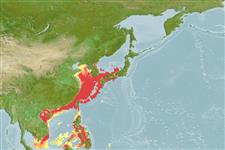Common names from other countries
Environment: milieu / climate zone / depth range / distribution range
экология
мигрирует в океане (Ref. 75927); пределы глубины 10 - 150 m (Ref. 275), usually 60 - 150 m (Ref. 75927). Subtropical; 15°C - 25°C (Ref. 75927); 41°N - 6°N, 104°E - 138°E (Ref. 1695)
Western Pacific: South and East China seas, Japan to Philippines and Indonesia.
Length at first maturity / Size / Вес / Возраст
Maturity: Lm ? range ? - ? cm Max length : 18.0 cm ML самец/пол неопределен; (Ref. 275); наибольший вес (опубликованные данные): 600.00 g (Ref. 1695)
Caught by otter trawls, pound nets, hoop nets and hook-and-line (Ref. 346). Sometimes found burrowing in the substrate (Ref. 275).
Life cycle and mating behavior
половая зрелость | размножение | нерест | икра | Fecundity | личинки
Members of the class Cephalopoda are gonochoric. Male and female adults usually die shortly after spawning and brooding, respectively. Mating behavior: Males perform various displays to attract potential females for copulation. During copulation, male grasp the female and inserts the hectocotylus into the female's mantle cavity where fertilization usually occurs. Life cycle: Embryos hatch into planktonic stage and live for some time before they grow larger and take up a benthic existence as adults.
Основная ссылка
ссылки | координатор | соавторы
Roper, C.F.E., M.J. Sweeney and C.E. Nauen. 1984. (Ref. 275)
Статус Красного Списка МСОП (Ref. 130435)
Статус СИТЕС (Ref. 108899)
Not Evaluated
Not Evaluated
Использование человеком
рыболовство: коммерческий
| FishSource |
инструменты
дополнительная информация
ресурсы в Интернет
Estimates based on models
Preferred temperature
(Ref.
115969): 11.6 - 23.2, mean 18.5 (based on 195 cells).
Prior r = 0.31, 95% CL = 0.20 - 0.47, Based on 1 full stock assessment.
Уязвимость
Low vulnerability (10 of 100).
